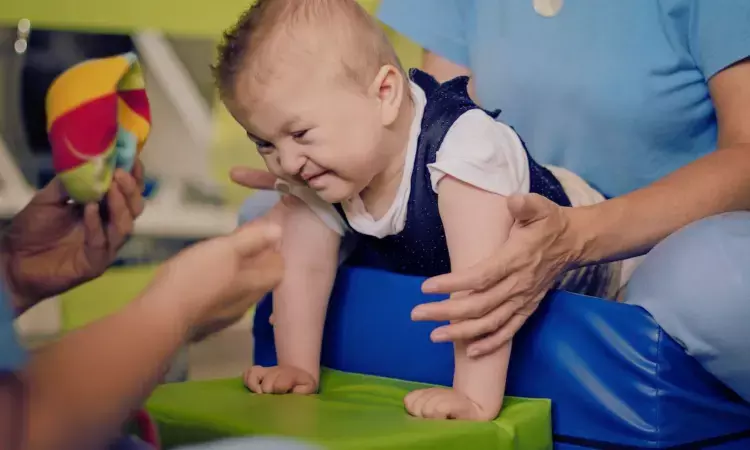- Home
- Medical news & Guidelines
- Anesthesiology
- Cardiology and CTVS
- Critical Care
- Dentistry
- Dermatology
- Diabetes and Endocrinology
- ENT
- Gastroenterology
- Medicine
- Nephrology
- Neurology
- Obstretics-Gynaecology
- Oncology
- Ophthalmology
- Orthopaedics
- Pediatrics-Neonatology
- Psychiatry
- Pulmonology
- Radiology
- Surgery
- Urology
- Laboratory Medicine
- Diet
- Nursing
- Paramedical
- Physiotherapy
- Health news
- Fact Check
- Bone Health Fact Check
- Brain Health Fact Check
- Cancer Related Fact Check
- Child Care Fact Check
- Dental and oral health fact check
- Diabetes and metabolic health fact check
- Diet and Nutrition Fact Check
- Eye and ENT Care Fact Check
- Fitness fact check
- Gut health fact check
- Heart health fact check
- Kidney health fact check
- Medical education fact check
- Men's health fact check
- Respiratory fact check
- Skin and hair care fact check
- Vaccine and Immunization fact check
- Women's health fact check
- AYUSH
- State News
- Andaman and Nicobar Islands
- Andhra Pradesh
- Arunachal Pradesh
- Assam
- Bihar
- Chandigarh
- Chattisgarh
- Dadra and Nagar Haveli
- Daman and Diu
- Delhi
- Goa
- Gujarat
- Haryana
- Himachal Pradesh
- Jammu & Kashmir
- Jharkhand
- Karnataka
- Kerala
- Ladakh
- Lakshadweep
- Madhya Pradesh
- Maharashtra
- Manipur
- Meghalaya
- Mizoram
- Nagaland
- Odisha
- Puducherry
- Punjab
- Rajasthan
- Sikkim
- Tamil Nadu
- Telangana
- Tripura
- Uttar Pradesh
- Uttrakhand
- West Bengal
- Medical Education
- Industry
Wearable robot-assisted gait training boosts support and assistance for cerebral palsy therapy: JAMA

A new study by Ja Young Choi and team found a novel torque-assisted wearable exoskeletal robot may be able to help children with cerebral palsy (CP) in addition to traditional therapy with therapeutic support and sufficient assistance. The findings of this study were published in the Journal of American Medical Association.
The most prevalent developmental motor condition in children is cerebral palsy. A wearable robot can be used for robot-assisted gait training (RAGT), which offers extensive overground walking experience. Thereby, this study was set to determine if overground RAGT with the help of an untethered, torque-assisted wearable exoskeletal robot, is beneficial for children with CP.
This single-blind, multicenter, randomized clinical investigation was carried out at 5 Korean rehabilitation facilities from September 1, 2021 to March 31, 2023. 90 CP children in grades II–IV of the Gross Motor Function Classification System were randomly assigned. While the control group underwent regular physical therapy for a similar number of sessions over the same period, the RAGT group received 18 RAGT sessions over the course of 6 weeks.
The Gross Motor Function Measure 88 (GMFM-88) score served as the main outcome measure. The GMFM-66, Pediatric Balance Scale, Pediatric Evaluation of Disability Inventory–Computer Adaptive Test (PEDI-CAT), Selective Control Assessment of the Lower Extremity, muscle and fat mass via bioelectrical impedance analysis, 6-minute Walking Test scores (the distance and oxygen consumption), and parameters of gait calculated via 3-dimensional analysis were the secondary outcome measured. All the patients underwent evaluations after baseline, after the conclusion of the 6-week intervention, and during the 4-week follow-up.
Out of the 98 children enrolled in the research, 87 (86.7%) finished the intervention. Also, 37 and 41 individuals were randomized to the RAGT and control groups, respectively. At the post intervention assessment, the RAGT group's change in the GMFM-88 total, GMFM-66, GMFM-E, and PEDI-CAT responsibility domain scores considerably outpaced the individuals of the control group which indicated independence in daily life. When compared to the control group, the RAGT group demonstrated noticeably larger gains in balance control and the Gait Deviation Index at the 4-week follow-up.
In summary, using a wearable robot for overground RAGT significantly enhanced balance control, gross motor function, and gait pattern in this randomized clinical trial than a matched traditional PT group. Children with cerebral palsy would benefit from this novel torque-assisted wearable RAGT, which supports power-as-needed control, encourages walking exploration and offers rigorous gait training.
Source:
Choi, J. Y., Kim, S. K., Hong, J., Park, H., Yang, S., Park, D., & Song, M.-K. (2024). Overground Gait Training With a Wearable Robot in Children With Cerebral Palsy. In JAMA Network Open (Vol. 7, Issue 7, p. e2422625). American Medical Association (AMA). https://doi.org/10.1001/jamanetworkopen.2024.22625
Neuroscience Masters graduate
Jacinthlyn Sylvia, a Neuroscience Master's graduate from Chennai has worked extensively in deciphering the neurobiology of cognition and motor control in aging. She also has spread-out exposure to Neurosurgery from her Bachelor’s. She is currently involved in active Neuro-Oncology research. She is an upcoming neuroscientist with a fiery passion for writing. Her news cover at Medical Dialogues feature recent discoveries and updates from the healthcare and biomedical research fields. She can be reached at editorial@medicaldialogues.in
Dr Kamal Kant Kohli-MBBS, DTCD- a chest specialist with more than 30 years of practice and a flair for writing clinical articles, Dr Kamal Kant Kohli joined Medical Dialogues as a Chief Editor of Medical News. Besides writing articles, as an editor, he proofreads and verifies all the medical content published on Medical Dialogues including those coming from journals, studies,medical conferences,guidelines etc. Email: drkohli@medicaldialogues.in. Contact no. 011-43720751


